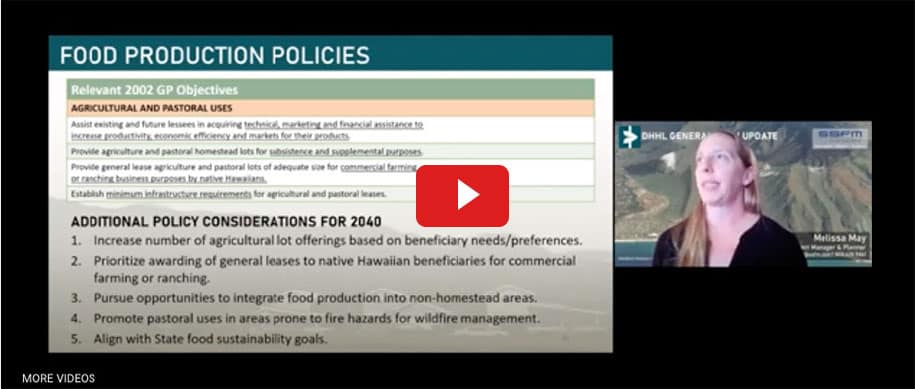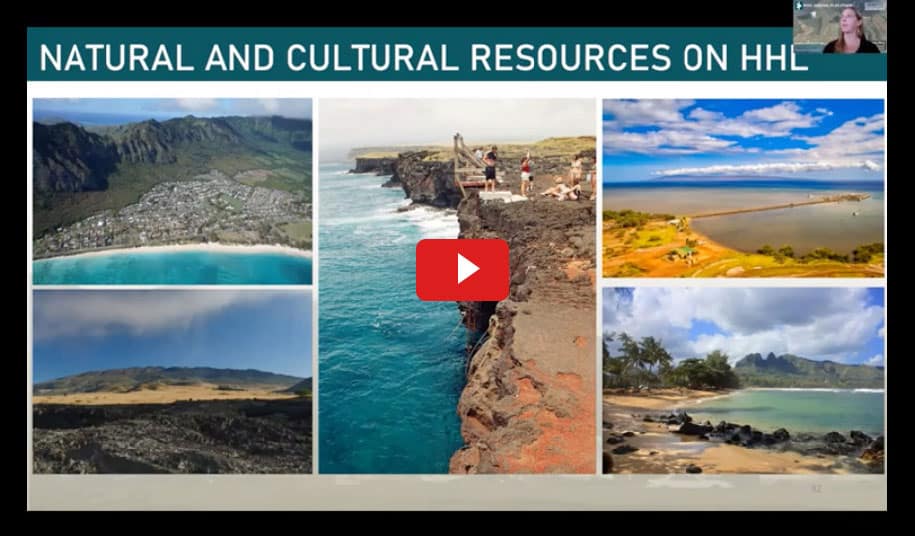
Melissa May AICP
Manager
Senior Planner | Associate
Resilience Practice Leader
Manager, Strategic Services Group
DEPARTMENT OF HAWAIIAN HOME LANDS ADOPTS 2022 GENERAL PLAN UPDATE
The Hawaiian Homes Commission Act, legislated by the U.S. Congress in 1921, established the Department of Hawaiian Home Lands (DHHL).
Its mission is to manage its approximately 200,000 acres of landholdings with the purpose of realizing Prince Jonah Kūhiō Kalanianaʻole’s vision of rehabilitating native Hawaiians by returning them to the land.
DHHL’s land management is guided by a General Plan which sets its policy direction over a 20 year horizon. Last updated in 2002, SSFM recently served as lead consultant to perform a comprehensive update of the General Plan. The update occurred over a two-year planning process, culminating in its adoption by the Hawaiian Homes Commission (HHC) in 2022. The updated plan sets the vision and codifies goals and policies that will guide the Commission decision-making for the next two decades. The topics addressed include Land Use and Water Resources, Infrastructure, Housing, Food Production, Healthy Communities, Natural and Cultural Resource Management, and Economic Development and Revenue Generation. The final plan is intended to provide for orderly social, physical, and economic development of all Hawaiian Home Lands.
In accordance with DHHL’s Administrative Rules, which were updated in 2018, the plan update includes several elements that were not addressed in previous General Plans. These include defining and establishing land use designations for use in DHHL lands statewide, establishing criteria for their application, providing a framework for monitoring and evaluation, and identifying infrastructure level of service criteria for each land use designation. Adapting to the impacts of climate change on DHHL lands was also discussed in the plan for the first time, with goals and policies oriented toward enhancing the resilience of existing and future homestead communities to climate change and promoting climate change mitigation measures such as energy efficiency and renewable energy.
The plan update process involved collaboration between the DHHL Planning Office, the Hawaiian Homes Commission Investigative Committee and statewide native Hawaiian beneficiaries. “This document is the result of months of consultation with homesteaders and applicants on the Waiting List,” said Deputy to the Chair Tyler Iokepa Gomes. “As we enter into the next 100 years of this program, it’s critical that we have this foundation to chart the direction and use of trust lands to continue the work to fulfill Kūhiō’s vision.”
The tasks involved in the plan update included evaluating the progress since the 2002 General Plan, identifying current issues and trends, drafting white papers on land use, infrastructure, climate change, and monitoring/evaluation, facilitating beneficiary consultation and stakeholder engagement, and producing the final plan document. The majority of the outreach took place during the COVID-19 pandemic, with three rounds of beneficiary consultation meetings hosted virtually. The virtual meetings drew native Hawaiian beneficiaries from across the state, nationwide, and internationally. A final round of beneficiary consultation was conducted in-person at open houses on each of the Islands. An online virtual open house was also available.
To view the General Plan, or learn more about DHHL’s planning system, visit https://dhhl.hawaii.gov/po/general-plan-2022/

DEPARTMENT OF HAWAIIAN HOME LANDS ADOPTS 2022 GENERAL PLAN UPDATE
The Hawaiian Homes Commission Act, legislated by the U.S. Congress in 1921, established the Department of Hawaiian Home Lands (DHHL).
Its mission is to manage its approximately 200,000 acres of landholdings with the purpose of realizing Prince Jonah Kūhiō Kalanianaʻole’s vision of rehabilitating native Hawaiians by returning them to the land. DHHL’s land management is guided by a General Plan which sets its policy direction over a 20 year horizon. Last updated in 2002, SSFM recently served as lead consultant to perform a comprehensive update of the General Plan. The update occurred over a two-year planning process, culminating in its adoption by the Hawaiian Homes Commission (HHC) in 2022. The updated plan sets the vision and codifies goals and policies that will guide the Commission decision-making for the next two decades. The topics addressed include Land Use and Water Resources, Infrastructure, Housing, Food Production, Healthy Communities, Natural and Cultural Resource Management, and Economic Development and Revenue Generation. The final plan is intended to provide for orderly social, physical, and economic development of all Hawaiian Home Lands. In accordance with DHHL’s Administrative Rules, which were updated in 2018, the plan update includes several elements that were not addressed in previous General Plans. These include defining and establishing land use designations for use in DHHL lands statewide, establishing criteria for their application, providing a framework for monitoring and evaluation, and identifying infrastructure level of service criteria for each land use designation. Adapting to the impacts of climate change on DHHL lands was also discussed in the plan for the first time, with goals and policies oriented toward enhancing the resilience of existing and future homestead communities to climate change and promoting climate change mitigation measures such as energy efficiency and renewable energy. The plan update process involved collaboration between the DHHL Planning Office, the Hawaiian Homes Commission Investigative Committee and statewide native Hawaiian beneficiaries. “This document is the result of months of consultation with homesteaders and applicants on the Waiting List,” said Deputy to the Chair Tyler Iokepa Gomes. “As we enter into the next 100 years of this program, it’s critical that we have this foundation to chart the direction and use of trust lands to continue the work to fulfill Kūhiō’s vision.” The tasks involved in the plan update included evaluating the progress since the 2002 General Plan, identifying current issues and trends, drafting white papers on land
use, infrastructure, climate change, and monitoring/evaluation, facilitating beneficiary consultation and stakeholder engagement, and producing the final plan document. The majority of the outreach took place during the COVID-19 pandemic, with three rounds
of beneficiary consultation meetings hosted virtually. The virtual meetings drew native Hawaiian beneficiaries from across the state, nationwide, and internationally. A final round of beneficiary consultation was conducted in-person at open houses on each of the Islands. An online virtual open house was also available.
To view the General Plan, or learn more about DHHL’s planning system, visit



Melissa May AICP
Manager
Senior Planner | Associate Resilience Practice Leader Manager, Strategic Services Group

